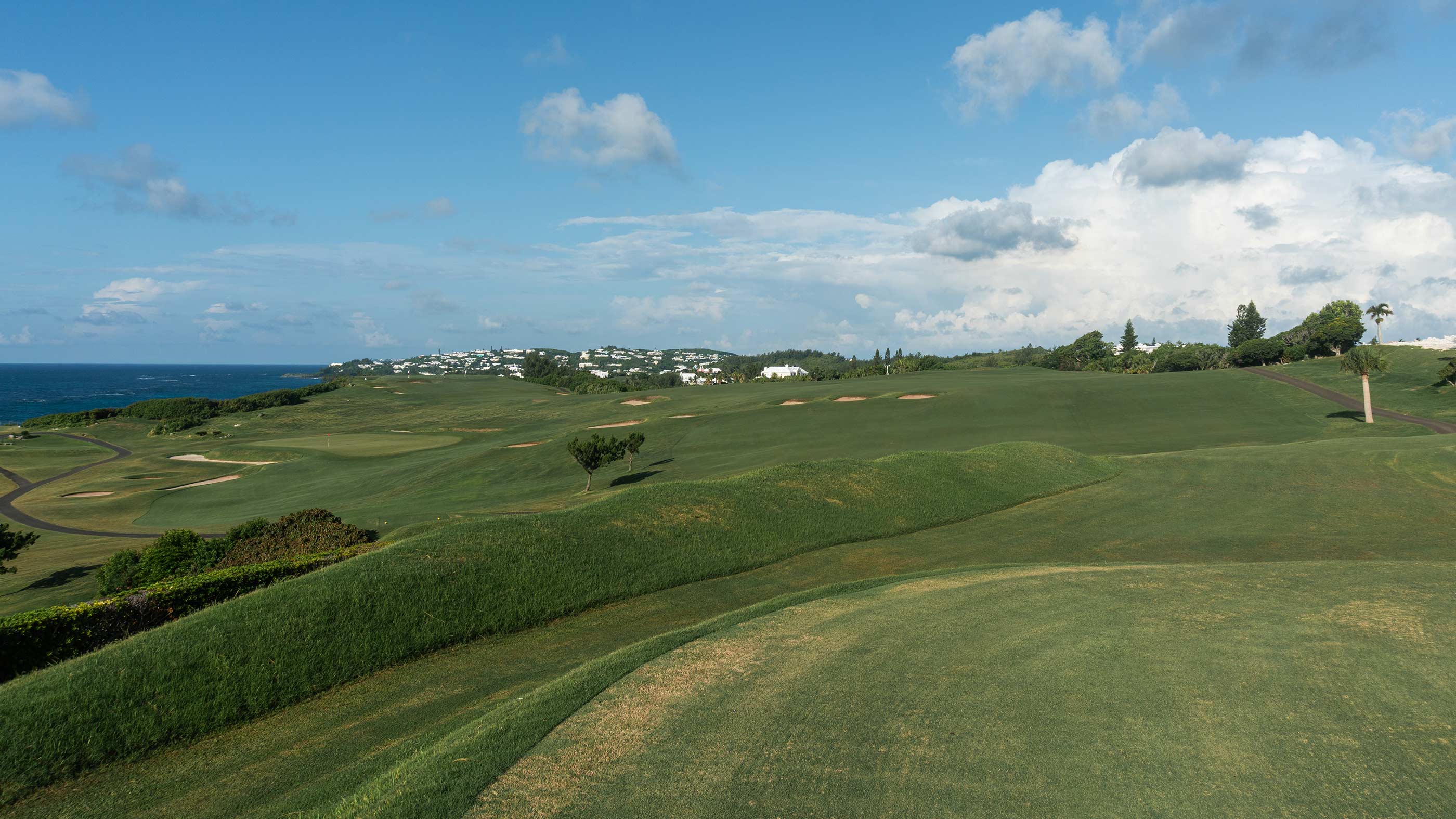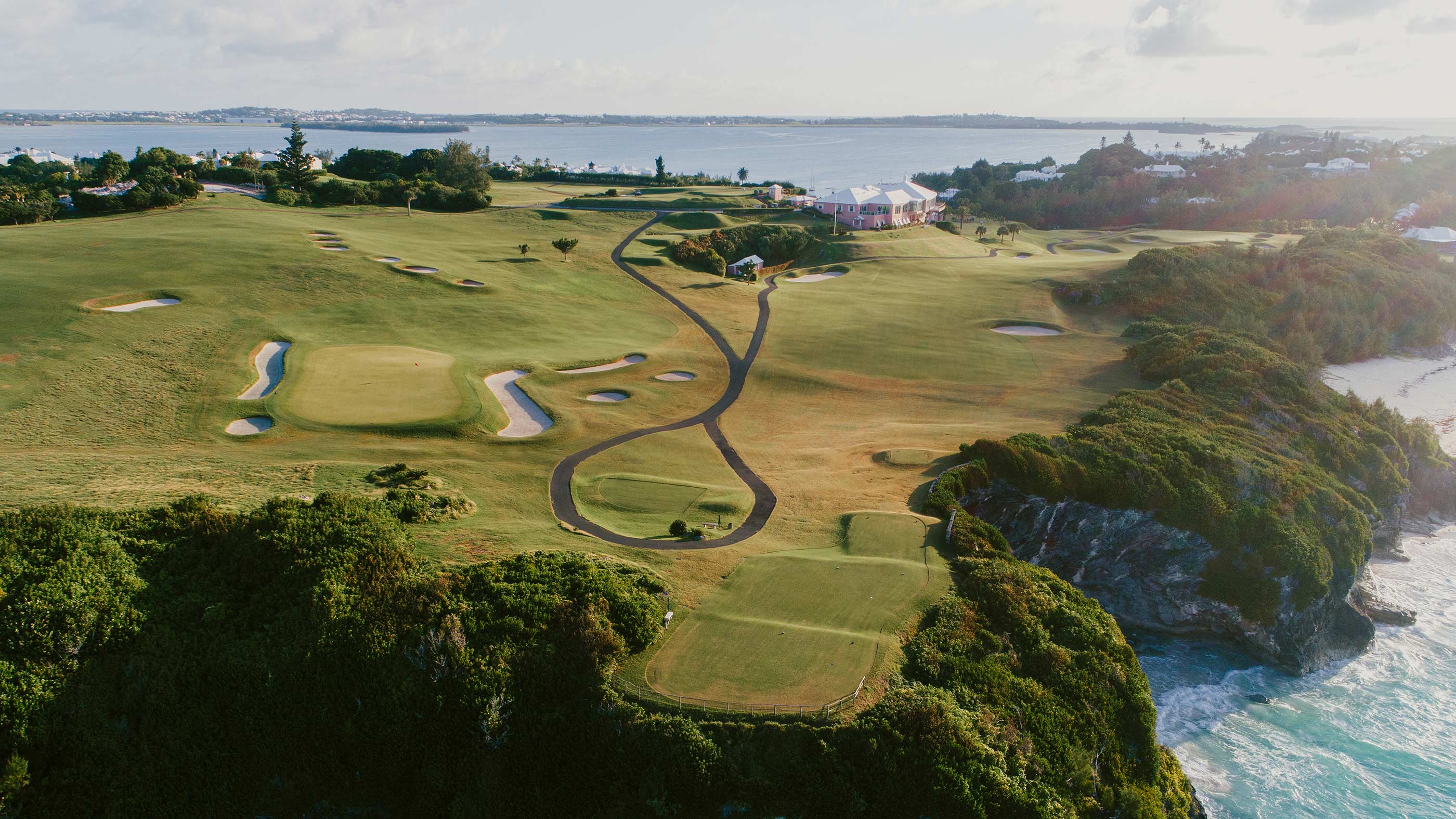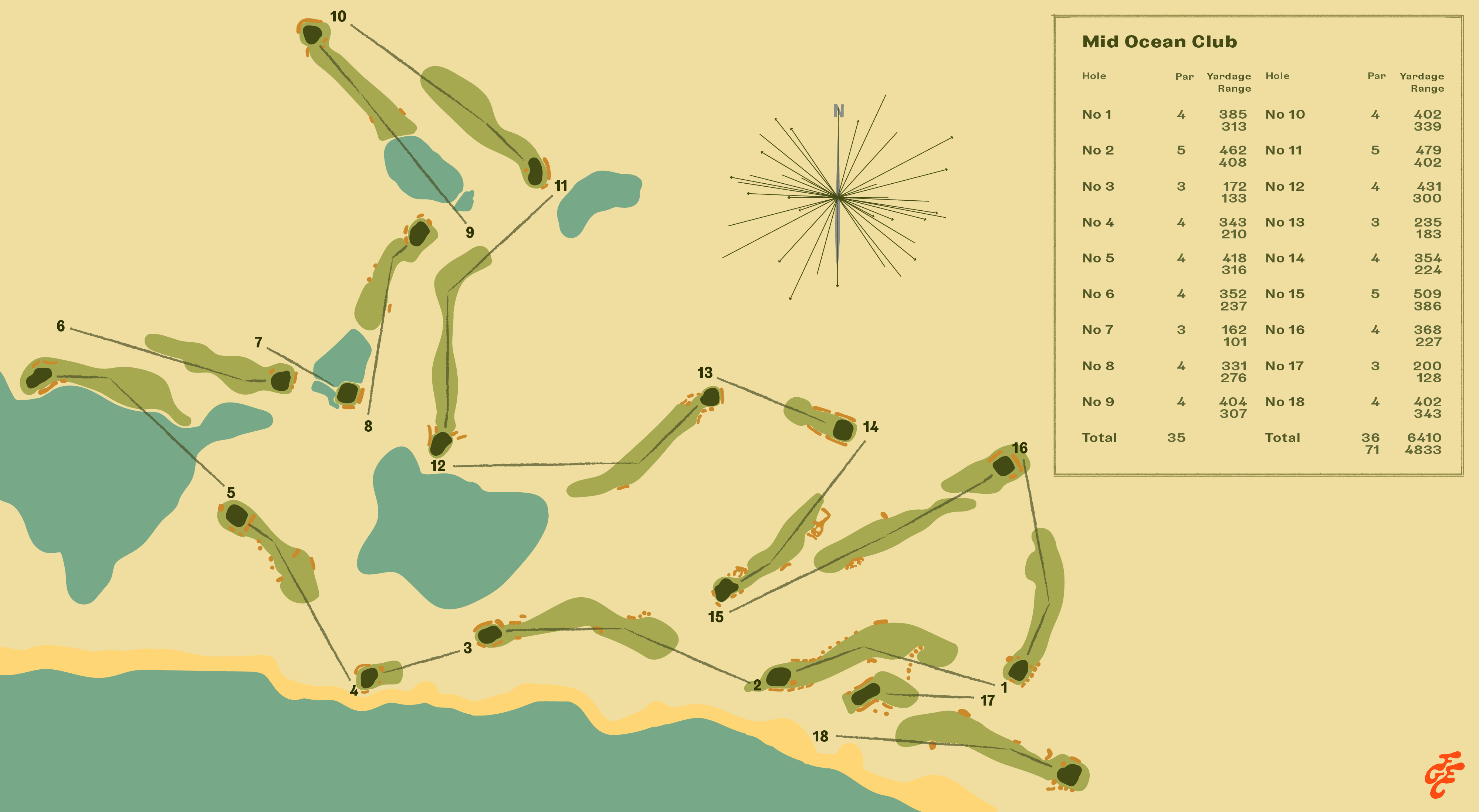Mid Ocean Club
C.B. Macdonald in paradise: the architect’s “ideal holes” combine with a seaside setting in Bermuda to make for one of the most visually stunning places to play golf in the world

Tucker's Town, Bermuda
C.B. Macdonald (original design, 1924)
Private
Mid Ocean Club and Golf in Bermuda Q&A with David Woodcock
A “Swan” Song, LIV’s depth problem, Rory’s “betrayal” and #FBF on Mid Ocean
C.B. Macdonald is known as the father of golf course architecture in the United States and has many designs still considered among the best in the world. His only design outside the U.S. lies in the middle of the Atlantic Ocean: Mid Ocean Club.
Built in the early 1920s, Mid Ocean Club was commissioned by the Withy Steamship Company as an attraction for when they brought clients to Bermuda. The island was originally used solely as a port for transatlantic shipments. In the 1900s, as transportation became safer and more readily available, Bermuda developed into a vacation destination as it is easily accessible from the East Coast.
Macdonald scoured Bermuda in search of the right piece of land and ultimately settled on a plot perfectly situated for golf on the northeast end of the island. The clubhouse resides on a bluff overlooking the ocean, and the course was routed between the Atlantic Ocean and the Harrington Sound. Built with longtime partner Seth Raynor, Macdonald’s design takes full advantage of its location, highlighting the local environment throughout. Mid Ocean Club’s historian, David Woodcock, told Fried Egg Golf that “seeing the course in person makes for a visual feast.”
As with many of his designs, Macdonald employed a series of his “ideal holes” at Mid Ocean Club. Together, they work with the remainder of Macdonald and Raynor’s holes to create one of the most visually stunning places to play golf in the world.
{{content-block-course-profile-mid-ocean-club-001}}
Take Note…
Templates galore. As you may expect from a Macdonald and Raynor product, there are numerous Template Holes at Mid Ocean Club. You’ll find Eden (No. 3), Alps (No. 4), Cape (No. 5), Short (No. 7), Road (No. 10), Biarritz (No. 13), Leven (No. 14), Punchbowl (No. 15), and Redan (No. 17) throughout your round.
Not even The Babe. Mid Ocean Club’s par-4 fifth hole wraps around Mangrove Lake. The hole plays approximately 400 yards on the scorecard and 320 yards as the crow flies from the modern member’s tee. It also plays about 50 feet downhill, making those yardages play much shorter. In 1937, Babe Ruth played in the club’s Invitational Tournament and attempted to drive the green. After coming up short twice, he played from the drop zone and ultimately made an 11 on the hole.
Beach club. Tucked behind the 18th green is the MOC Beach Pavilion. The Pavilion overlooks the Atlantic Ocean and features one of the most stunning restaurant views you can have on a golf course.
Don’t skip the muffin. The halfway house at Mid Ocean Club is not to be missed. Not only is Jessica, the woman who runs the house, an absolute delight and a ball of energy, but the homemade snacks are wonderful. The muffin was recommended to us and it did not disappoint.
Favorite Hole
No. 5 (“Cape”), par 4, 327-433 yards
In a place as scenic as Mid Ocean Club, you expect to have some visually stimulating golf holes. And while there are many memorable ones, the par-4 fifth is genuinely jaw-dropping. One of Macdonald and Raynor’s Cape templates, the fifth is an all-world golf hole. High atop the cliff, the tee shot drops roughly 50 feet to the fairway that wraps around Mangrove Lake. The green continues to wrap around, ultimately winding up at nearly a 90-degree angle to the tee. The hole rewards those who carry the lake up the left by giving them a gentle backstop on the green for their approach. Those who played right off the tee not only have a longer shot in, but have to negotiate a green that wants to do nothing but kick their ball off the surface.
The legend of the Cape hole at Mid Ocean Club more than lived up to my expectation as its strategy matched the scenery. The tee shot is incredibly intimidating and it only gets worse when the wind picks up. There may be better golf holes in the world, but there aren’t many.
Favorite Hole
No. 5 (“Cape”), par 4, 327-433 yards
In a place as scenic as Mid Ocean Club, you expect to have some visually stimulating golf holes. And while there are many memorable ones, the par-4 fifth is genuinely jaw-dropping. One of Macdonald and Raynor’s Cape templates, the fifth is an all-world golf hole. High atop the cliff, the tee shot drops roughly 50 feet to the fairway that wraps around Mangrove Lake. The green continues to wrap around, ultimately winding up at nearly a 90-degree angle to the tee. The hole rewards those who carry the lake up the left by giving them a gentle backstop on the green for their approach. Those who played right off the tee not only have a longer shot in, but have to negotiate a green that wants to do nothing but kick their ball off the surface.
The legend of the Cape hole at Mid Ocean Club more than lived up to my expectation as its strategy matched the scenery. The tee shot is incredibly intimidating and it only gets worse when the wind picks up. There may be better golf holes in the world, but there aren’t many.
{{mid-ocean-favorite-hole-5-gallery}}
Overall Thoughts
"Bermuda was a hard task, owing to climatic conditions, but all difficulties have been surmounted, and I am confident the course will stand in golfing circles as an achievement in a semi-tropical climate as great as the National Golf Links of America has been in the temperate zone." –C.B. Macdonald in his letter to one of Mid Ocean Club's founding members.
Mid Ocean Club exists due to a series of miraculous events. The first such miracle occurred more than 30 million years ago when a one-of-a-kind volcano erupted from the ocean floor and created what is now known as the island of Bermuda. Ships lost at sea ultimately brought people to the island before wars and international trade routes kept inhabitants in this ocean paradise that isn’t exactly hospitable to the outside world. Its wild terrain, exposure to the elements, and dearth of natural resources make it a difficult place to do, well, anything. And yet, with a great deal of talent, immense imagination, and plenty of funding, Macdonald and Raynor made the most of the miracles.
The sheer impossibility of Mid Ocean Club’s existence is key to the course’s identity. A magical, almost mythical venue should feel the same when actually on site. Macdonald knew this going into the land selection and settled on a property that would allow him to balance world-class golf in an otherworldly location. To accomplish this, Macdonald executed a routing that both entertains the player by accentuating the tropical locale while also testing them with architectural interest.
The Routing
When building a golf course in the middle of the ocean, there is the obvious inclination to build holes along the water. But given that the entire island of Bermuda is smaller than the square mileage of the Orlando International Airport, oceanfront property was hard to come by, even in the 1910s. Mid Ocean Club has waterfront holes, but not nearly as many as you’d anticipate. Only the first green, second tee box, third green, fourth tee, and 18th hole actually sit along the ocean. And yet, you don’t feel robbed of water views throughout the round because of Macdonald’s clever routing.
The round starts on the highest point of the property. High above the ocean and overlooking Nos. 1, 17, and 18, the opening tee shot is breathtaking. Not that you’d forget you were in a tropical paradise, but Macdonald wasted no time in reminding you. The first green plays right up to a towering cliff edge, and any left pin will remind you that you are playing golf on the edge of the world.

The second tee abuts the same cliff but ventures inland. Still, the dramatic drop and dogleg provide a hell of a test and at least two thrilling shots. Then, you return to the coast with the Eden par-3 third green, the second waterside green in the first three holes. The tee box on No. 4 sits directly behind the third green with only a picturesque fence separating you from the Atlantic Ocean. After taking a look back down the hill on the fourth green, you won’t see the ocean again until you reach the 16th green. Still, the brilliance of the opening stretch keeps the water’s many shades of blue in your head for hours.
In a unique twist, the iconic par-4 fifth hole is the transition hole at Mid Ocean Club. You move away from the ocean and into the meat of the property, one filled with lower-lying holes, mangroves, palm trees, lakes, lagoons, and vacation homes. The tee shot on No. 5 may be the most dramatic of any I’ve ever hit, and the walk down the hill sets you off on a new adventure.
Following the ocean setting of the opening four holes and stunner of the Cape hole, Macdonald weaves you back through the lower areas of the property, taking full advantage of the sidehill lies and elevation change on his way. Short par 4s in Nos. 6, 8, and 10 require delicate approach shots and are balanced against longer holes in Nos. 9, 11, and 12. This section of the property does feature some serious land movement, but it is largely played in the lowest areas of the course.
{{mid-ocean-11-12-14-fairway-gallery}}
In Scotland’s Gift: Golf, Macdonald wrote about how he stuck to the valleys in this stretch because that was where the soil was. Therefore, it was more natural and feasible to reliably grow grass in a temperate climate. I have no doubt that was true, however, you have to wonder if the real estate value of the high ground was also a contributing factor. Regardless, by sticking to the valleys, Macdonald was able to route a golf course that never overextends the player. By no means is Mid Ocean Club an easy walk, but given the severity of the land, a lesser architect could have turned a dream location into a nightmare.
The climb out of the low area begins with the approach into No. 15, but the real uphill hike is the par-4 16th, a steep mountain of a golf hole that climbs back to the first tee. This journey is a reminder that had Macdonald tried to use more of the high ground for his routing it would have come with serious physical strain. Not always a bad thing, but when you’re playing golf in paradise, a heart rate over 100 bpm probably isn’t what you’re looking for.
Macdonald’s routing saves the true oceanfront land for the final two holes. The 17th is a long Redan that plays parallel to No. 1 and is very much in play for a left tee shot off the first. It’s a long hole that plays even longer with the prevailing summer wind. You then climb to the 18th tee box, a perch that is benched up against the ocean. It’s as stunning a vista as you’ll ever see. Waves crash below, birds chirp from above, and the salty wind sends your tee shot towards the coral pink clubhouse along the cliff’s edge.

The Architecture
While the routing and its complex pieces are the star of the show at Mid Ocean Club, a good walk can only be so entertaining. It is the marriage of the routing with amazing architectural features that really sets Mid Ocean Club over the top.
In its template holes, of which the course has many, Mid Ocean Club probably has the best Cape hole (No. 5) of any in the world and may have the best Alps (No. 4) that isn’t No. 4 at Fisher’s Island. The par-5 15th is called Punchbowl, but you could also make the case for No. 9 being a punchbowl green (and an all-world one at that). What really stands out about nearly all of the template uses at Mid Ocean Club is the uniqueness of their uses in relation to other Macdonald and Raynor courses. The dramatic downhill nature of the Cape, short-par 4 use of the Road Hole green, and the use of the Redan as the penultimate hole in a focal location on property really highlight each and make them stand out from others.
Some love also needs to be given to the numerous one-off designs found at Mid Ocean. It's in these holes where Macdonald’s boldness, as well as that of Raynor and Charles Banks, who were on site for most of the construction, really shine through. This can be especially felt in the shaping on the brute opener, devilish par-4 eighth, short par-4 10th, and uphill par-4 16th. The willingness to take these measures in such a location adds a layer of intrigue to Mid Ocean Club. In a place as remote and untamed as Bermuda, the architecture required to make the golf course match its location was immense.
The only knock against Mid Ocean Club’s architecture is that some of it is getting a bit tired. Not in that the designs have been overused, but in that the course itself is in need of a refresh. The course boasts Macdonald’s four classic template hole par 3s — Eden, Short, Biarritz, and Redan — and yet none of them really blew me away. I think the two par 3s on the front are particularly uninteresting in their current states. But it’s not just the par 3s. Robert Trent Jones added some length to the course in the 1950s, but Mid Ocean Club really hasn’t undergone any design upkeep in its 100 years of existence. Understandably, that has led to some green and fairway shrinkage. A master plan by Gil Hanse and Jim Wagner has been proposed, but it’s my understanding that the process for approving the changes is rather complicated. Alas, there is reason to believe that an even better version of Mid Ocean Club isn’t that far away.
2 Eggs
Make no mistake about it, Mid Ocean Club should be a 3-Egg course. It’s a jaw-dropping golf course at every turn and seamlessly blends its architectural chops with its location. Still, it is in need of a little TLC. New Superintendent Kenton Brunson is efforting some great changes, and if Hanse’s Master Plan is implemented, we could really see Mid Ocean Club’s full potential unleashed. That said, it is already a must-see and worth the trip to the Atlantic. And make sure to have a Dark 'n' Stormy.
Course Tour

{{mid-ocean-course-tour-01}}
Leave a comment or start a discussion
Get full access to exclusive benefits from Fried Egg Golf
- Member-only content
- Community discussions forums
- Member-only experiences and early access to events










Leave a comment or start a discussion
Lorem ipsum dolor sit amet, consectetur adipiscing elit. Suspendisse varius enim in eros elementum tristique. Duis cursus, mi quis viverra ornare, eros dolor interdum nulla, ut commodo diam libero vitae erat. Aenean faucibus nibh et justo cursus id rutrum lorem imperdiet. Nunc ut sem vitae risus tristique posuere. uis cursus, mi quis viverra ornare, eros dolor interdum nulla, ut commodo diam libero vitae erat. Aenean faucibus nibh et justo cursus id rutrum lorem imperdiet. Nunc ut sem vitae risus tristique posuere.